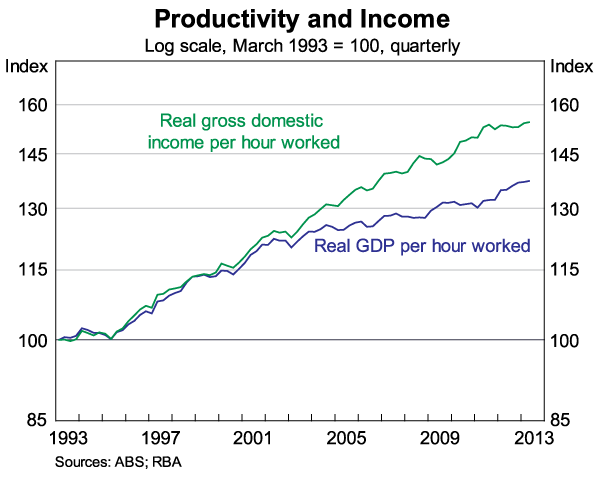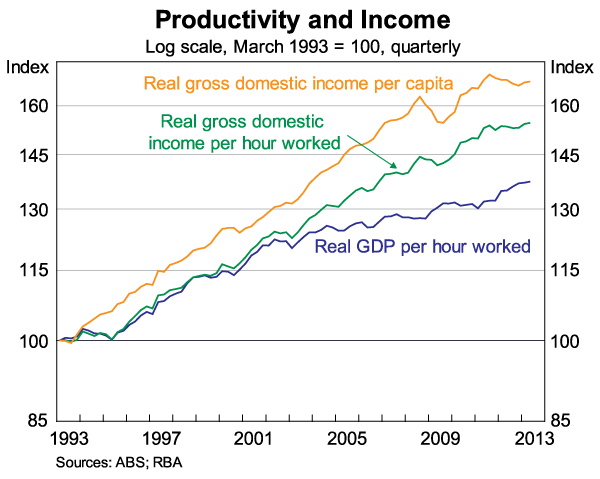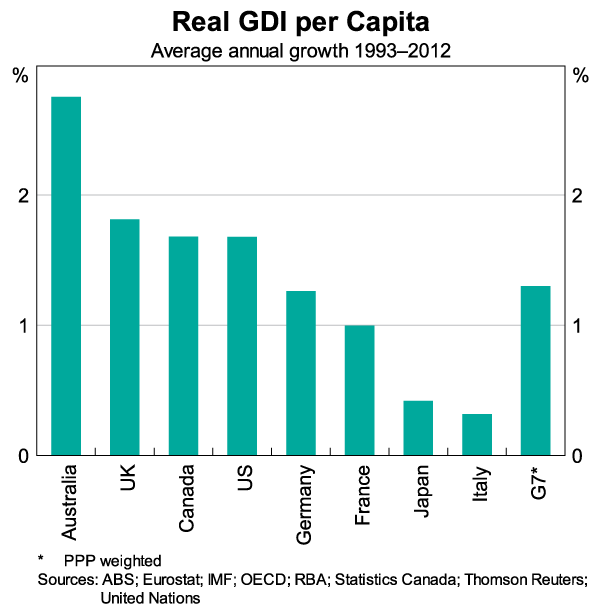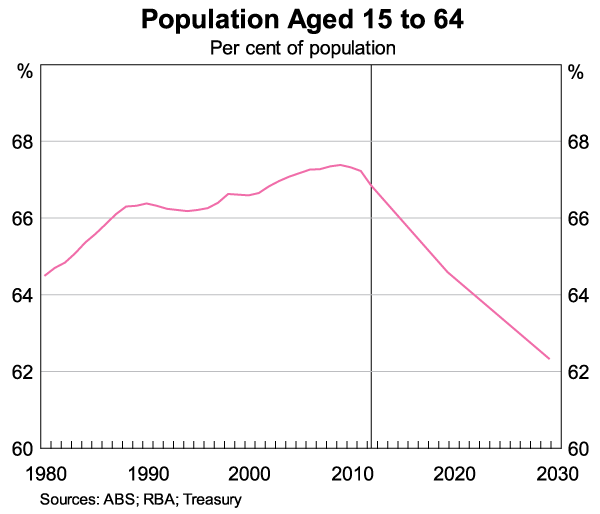Speech Productivity and Infrastructure
I would like to extend a warm welcome to you all to Sydney for this conference on Productivity Measurement, Drivers and Trends. You are meeting in one of the world's great cities and I hope you enjoy your time here. You are also discussing one of the world's great challenges – boosting productivity and increasing people's living standards. The conference organisers have put together a distinguished array of speakers to help us make some progress on this critically important issue and I am delighted to be able to participate in those discussions.
I would like to divide my remarks this morning into two parts, both of which will have a distinctly Australian perspective. First, I will discuss recent trends in productivity growth in Australia and the significant challenge that lies ahead of us. And then second, I will discuss the important role that investment in infrastructure can make to boosting productivity growth and our standard of living.
Productivity: The Challenge that Lies Ahead
I would like to start with a graph that I am fond of presenting (Graph 1). It has two lines. The first shows how real income per hour worked in Australia has increased over the past two decades (the green line) – this is a pretty good proxy for the growth in our real purchasing power per hour worked. The second line shows how the amount of output produced per hour worked has increased over this same period (the blue line) – this is the conventional measure of labour productivity growth.

There are two main observations that I would like to make based on this graph.
The first is that over the past two decades we have seen unusually strong growth in the average real income generated by each hour of work in Australia. Since 1993, our effective purchasing power for each hour of work has increased by a cumulative 55 per cent, or around 2¼ per cent per year on average. This is much faster than in the previous decade and faster than in almost any other industrial country.
The second observation is that the source of this very strong growth in real purchasing power has changed over time. In the 1990s, the source was strong productivity growth, as is evident from the relatively steep slope of the blue line. Over these years, we benefited from a noticeable pick-up in productivity growth, partly due to a period of substantial economic reform.
However, the story over the past decade is quite different, with productivity growth being noticeably slower.[1] The good news is that this did not lead to slower growth in our living standards (this is apparent in the two lines moving apart gradually). The reason for this is the very substantial increase in Australia's terms of trade over this period. With rapid growth in Asia pushing up the prices of commodities, Australia's export prices increased substantially relative to our import prices. As Glenn Stevens has pointed out, over time we have been able to buy more and more flat screen televisions for each ton of iron ore that we have sold overseas.[2] It is this increase in the average value of what we produce per hour of work – not so much an increase in the average amount that we produce per hour – that has been central to the increase in our living standards over the past decade.
Before I discuss the implications of this, I would like to add one further line to this graph (Graph 2). This third line shows how real income per capita (the orange line) – as opposed to per hour worked – has increased over time. As you can see, the rise in real income per capita has been even faster than the rise in real income per hour worked, which has been faster than the rise in productivity. Since 1993, average real income per capita has increased by almost 70 per cent, or nearly 2¾ per cent per year on average. Again, this is much faster than we experienced in earlier decades and faster than in other advanced economies (Graph 3). By way of comparison, over this same period, there has been a cumulative increase in real income per capita across the G7 economies of just 28 per cent, or around just 1¼ per cent per year on average.


An important factor contributing to the strong growth in per capita income in Australia has been our favourable demographics. Over the past couple of decades, we have been in somewhat of a sweet spot. While the population has been ageing, there has been a steady rise in the share of the population in the 15 to 64 age group due to a decline in the percentage of children in the population (Graph 4). In addition, there has been a substantial rise in the share of the working-age population that is in employment, as the unemployment rate has trended down and the participation rate has trended up. As a result of these trends, there has been a noticeable increase in the number of hours worked relative to the population, which has boosted growth in measured output.

So in summary, the past two decades have been very good ones for the Australian economy. While not everybody in the community has benefited equally, there has been a very substantial improvement in our average standard of living since the early 1990s. This improvement has exceeded growth in productivity by a substantial margin. For this to occur over such a long period is very unusual as growth in productivity and living standards are typically closely linked. We have found ourselves in this rather fortunate position because of both our favourable terms of trade and our favourable demographics.
Looking forward, it is unlikely that these favourable developments will be repeated. While we can't be sure, it is more likely that the terms of trade will decline from here rather than increase further from what is a very high level by historical standards. And in terms of Australia's demographics, the sweet spot is now behind us. At some point over coming years, the share of the working-age population in employment is likely to decline, given the ageing of the population that is occurring.[3]
A hint of what could lie ahead can be seen in Graph 2. Looking at just the past few years, some increase in productivity growth is apparent, but at the same time, there has been little increase in real income per capita – the top and bottom lines are starting to come together again. Recently, we have been producing more output per hour worked, but the decline in our terms of trade and slower growth in hours worked have weighed on growth in our per capita income.[4]
If this pattern were to continue, as seems likely, the Australian economy faces a substantial challenge. Over the next decade or so, if we are to achieve anything like the type of growth in real per capita income that we have become used to, then a substantial increase in productivity growth will be required. We can no longer depend on a rising terms of trade and favourable demographics to make us richer. If this lift in productivity growth does not take place, then we will need to adjust to some combination of slower growth in real wages, slower growth in profits, smaller gains in asset prices and slower growth in government revenues and services – in short, slower growth in our average living standard. So the debate about productivity should not be seen as an esoteric one just for economists. Productivity growth matters and it matters a lot to our future living standards.
On the positive side, we have seen some signs that productivity growth has picked up a bit recently. Many firms that we talk with – particularly those affected by the high exchange rate – report that they have made serious efforts over recent years to make their operations more efficient. And, as the resources investment boom transitions to the resources exports boom, stronger growth in productivity is expected, as the production phase is often less labour intensive than the investment phase.
There is thus some basis for optimism. Even so, the task of generating a sustained and widespread pick-up in productivity needs to be high on our national agenda. It is a task where monetary policy can make a contribution by keeping inflation low and stable so that people can make decisions without having to worry about the distorting effects of high and variable inflation. Our medium-term inflation targeting framework – which has been in place for two decades now – has achieved this and we are committed to making sure that we continue to deliver.
But realistically, the additional contribution of monetary policy to improving productivity growth is only modest. The solutions clearly lie elsewhere, in the hands of both the private and the public sector. Improving productivity is not simply a matter of the ‘government fixing the problem’. The private sector has a central role to play too, as it is the private sector that is the main developer of new products, the main source of innovation and the main employer of people. Of course, the environment in which private businesses take and implement their decisions is heavily influenced by the public sector. As Gary Banks, the former head of the Productivity Commission, has pointed out, the public sector has an important influence on the incentives that firms face and on their ability to respond to those incentives. In effect, it helps set the ‘rules of the game’.[5]
There is no shortage of ideas on how to boost our productivity. Last year Gary Banks also provided us with a very useful ‘to do’ list and the Business Council of Australia has also recently contributed to the debate.[6] The difficulties are in deciding which ideas to pursue and in generating the political support for changes that are in the national interest but may disadvantage some sections of the community.
Investment in Infrastructure
Rather than recite the long list of possibilities, I instead want to focus on just one issue – and that is infrastructure. This is not to imply that infrastructure is necessarily the most critical issue. But it is an important one and it is one that is quite closely connected to the world of finance. I also want to make it clear that my comments are primarily about the medium term, rather than being focused on the short-term cyclical situation.
I suspect few of you would disagree with the idea that improving our infrastructure is important if Australia is to compete successfully in international markets in the years ahead. Over recent times, we have done quite well in building the infrastructure needed to export resources to the rest of the world. But we need to do more if we are to achieve that same success elsewhere. In the years ahead, it is unlikely that Australia's comparative advantage will lie in the production of standardised mass-produced manufactured goods for the global market. Instead, we have tremendous opportunities in a range of more specialised high value-added goods and services, where it is the quality of our ideas and the quality of our execution that is the key. Whether or not we can seize these opportunities depends critically on our human capital and our infrastructure.
Looking back at our recent experience with infrastructure, I find it difficult to escape the conclusion that we are falling short in some areas, particularly in parts of our transportation system – both private and public. Many of you have no doubt felt the frustration of moving around our cities. In my own case, when I am experiencing this frustration, I sometimes feel the economist side of my brain turn on. When this happens I can't help but think that surely there are investments in transport infrastructure that would yield a social rate of return greater than the cost of financing. At other times, I think that better use could be made of the existing infrastructure with a different pricing regime. I suspect that, on both scores, the economist part of my brain is right.
The benefits of investment in transportation infrastructure are well known.[7] Some of these are quite obvious, while others are more difficult to see, although no less important. Among the more obvious benefits is a reduction in travel times and costs for both people and goods. There can also be favourable social impacts through reducing travel stress and increasing the connectedness of communities. And there are environmental benefits as well.
One of the less obvious benefits is what economists sometimes call agglomeration spillovers. Effective transportation networks deepen markets. They bring consumers closer to more businesses, and they bring workers in contact with more opportunities. These deeper markets and connections promote competition. They promote greater specialisation by both firms and workers. And they promote innovation and a more dynamic economy. While the internet has some of these same effects, person-to-person contact remains an essential part of business, education and innovation. Poor transportation makes this contact difficult and hurts our national productivity.
Another less obvious effect of transportation systems is on the cost of housing. There are many factors that contribute to the cost of housing, but among these is the nature of a city's transportation system. When housing prices are high, it is largely because land prices are high. And, land prices are high when there is a ‘shortage’ of well-located land. We cannot do much about the physical supply of land, but investment in transportation infrastructure – by making it easier to move around the city – can increase the supply of ‘well-located’ land. And when supply increases, prices adjust. This means that underinvestment in transportation networks tends to put upward pressure on housing costs.[8]
Given these various effects, my own view is that there are significant opportunities for additional investment in transportation infrastructure and for using the existing infrastructure more efficiently. Doing so would promote productivity growth in Australia and contribute to advancement of the overall welfare of our citizens.
The potential challenges in this area are, however, significant. I would like to highlight three of these.
The first is the governance of project selection. Clearly, not all investments in transport are a good idea, and some ideas are much better than others. There is, I detect, a deal of scepticism in the public's mind about how projects are selected. This scepticism weakens public support for large-scale investment in infrastructure. Many people are concerned that money will be wasted and that political considerations will trump economic considerations.
So strong governance is critical to make sure money is spent wisely in this area. There is no substitute for rigorous and transparent cost-benefit analysis. In Australia, we have made some progress in this area over recent times through bodies like Infrastructure Australia. Building public confidence in the governance process not only helps ensure that the most pressing projects are selected, but also helps build public confidence that the money is being spent wisely.
This brings me to the second potential challenge – that of financing. It is no use identifying infrastructure projects with large potential gains if a way cannot be found to finance them. The financing challenge arises not because of a lack of money available to invest in infrastructure. Many private sector investors tell us that there are plenty of funds sitting on the sidelines waiting to be invested in infrastructure assets. The issue is more a reluctance of investors to take on the construction and patronage risks and/or the difficulties of charging for the use of infrastructure.
Given these challenges, the public sector can play an important enabling role, either through use of its own balance sheet directly or through risk-sharing arrangements with the private sector. Over recent times, we have seen a number of innovative public-private partnerships that have helped build important pieces of infrastructure in Australia, although some of these have had problems. More broadly, I suspect that one reason that the public sector has been a bit reluctant to play an even larger role is an aversion to public debt. In many important respects, this aversion to public debt has served Australia very well, but it has also limited the appetite to borrow to build public infrastructure.
Looking forward, we need to find a sustainable way in which to finance our infrastructure needs. Regardless of whether it is the private or public sector that does the financing, it is likely to be easier if we have mechanisms that generate a flow of revenue from the infrastructure. One obvious option is user charging that promotes the public good. Not only does this provide a revenue source to pay for the infrastructure over time, but it can help ensure that the infrastructure is used efficiently. Another option is the use of levies and other mechanisms to generate revenue from those who benefit most from the infrastructure.
Both of these options face obvious political difficulties – few of us like paying tolls or giving up part of a financial benefit that a piece of infrastructure might give us. So, I do not want to underestimate the challenge. But as a society, we have a lot riding on finding a way to pay for the infrastructure that we need to boost our productivity and improve our living standards. Hopefully, the work currently being undertaken by the Productivity Commission will point us in the right direction. And, in an international context, infrastructure financing will be one of Australia's priorities when we chair the G20 next year.
The third potential challenge is that of capacity constraints. Not only do we need to identify the best projects and find a way of financing them, but we also need to have the skilled workers to undertake them. Over recent times, private business investment has been at a record high level as a share of GDP because of the resources boom. At times, this has created pressures in parts of the labour market, including for workers with engineering and specialist building skills. This has meant that we simply have not had the capacity to do much more investment in infrastructure. However, over the next few years, resources investment is expected to decline significantly as we move from the investment to the export phase of the boom. This creates an opportunity for infrastructure investment to rise as a share of GDP without putting undue pressure on domestic capacity. Such a rise could assist in the necessary rebalancing of the economy and help create the basis for a further boost to our national productivity.
In conclusion, Australia faces a significant challenge over the coming years. While our exports are set to grow strongly, we will need to lift our rate of productivity growth substantially if we are to continue to enjoy the type of increases in our living standards that we have become used to. Meeting this challenge will require innovation by both the private and public sectors. Infrastructure is just one of the many areas that can play a role here. But if we are to maximise the benefits of our investment in infrastructure, that investment needs to be surrounded by strong governance, sound financing and pricing arrangements and due regard to the capacity constraints in the economy.
Thank you for listening and I look forward to your questions.
Endnotes
I would like to thank David Jacobs and Michelle Bergmann for their excellent assistance in preparing this talk. [*]
The slowdown in productivity growth is discussed in D'Arcy P and L Gustafsson (2012), ‘Australia's Productivity Performance and Real Incomes’, RBA Bulletin, June, pp 23–36, and Connolly E and L Gustafsson (forthcoming), ‘Australian Productivity Growth: Trends and Determinants’, Australian Economic Review, December 2013. [1]
See Stevens G (2010), ‘The Challenge of Prosperity’, Address to the Committee for Economic Development of Australia (CEDA) Annual Dinner, Melbourne, 29 November. [2]
See Australian Government (2010), Australia to 2050: Future Challenges, Intergenerational Report 2010, Commonwealth of Australia, Canberra. For a further discussion of demographic trends in Australia, see Productivity Commission (2013), An Ageing Australia: Preparing for the Future, Commission Research Paper, Canberra. [3]
Some of this slower growth in hours is cyclical in nature. [4]
See Banks G (2012), ‘Productivity Policies: The ‘To Do’ List’, Speech at the Economic and Social Outlook Conference, ‘Securing the Future’, Melbourne, 1 November. [5]
See Business Council of Australia (2013), Action Plan for Enduring Prosperity, July. [6]
For example, see Venables, AJ (2007) ‘Evaluating Urban Transport Improvements:
Cost-benefit Analysis in the Presence of Agglomeration and Income Taxation’,
Journal of Transport Economics and Policy, 41(2), 173–188,
and SGS Economics and Planning (2012), ‘Productivity and Agglomeration Benefits in Australian Capital Cities’,
Final Report, COAG Reform Council, June. Infrastructure Australia's approach
to the appraisal of wider economic benefits is outlined at
<http://infrastructureaustralia.gov.au/projects/files/Infrastructure_Priority_List_Submission_Template_Stage_7_Transport.doc>.
[7]
Kulish M, A Richards and C Gillitzer (2011), ‘Urban Structure and Housing Prices: Some Evidence from Australian Cities’, RBA Research Discussion Paper No 2011-03. [8]
